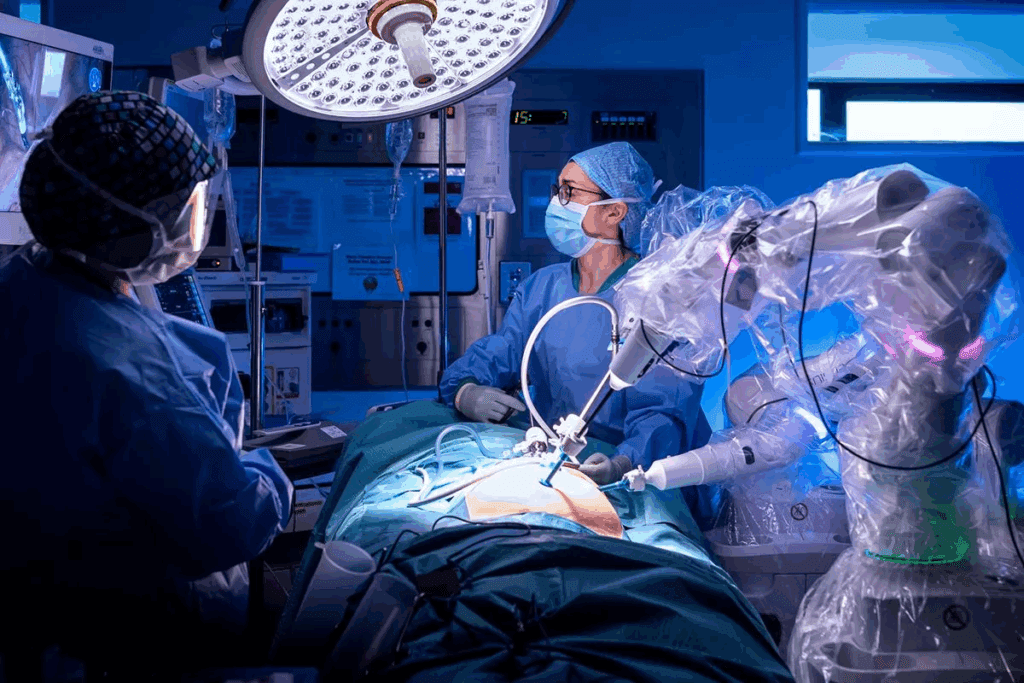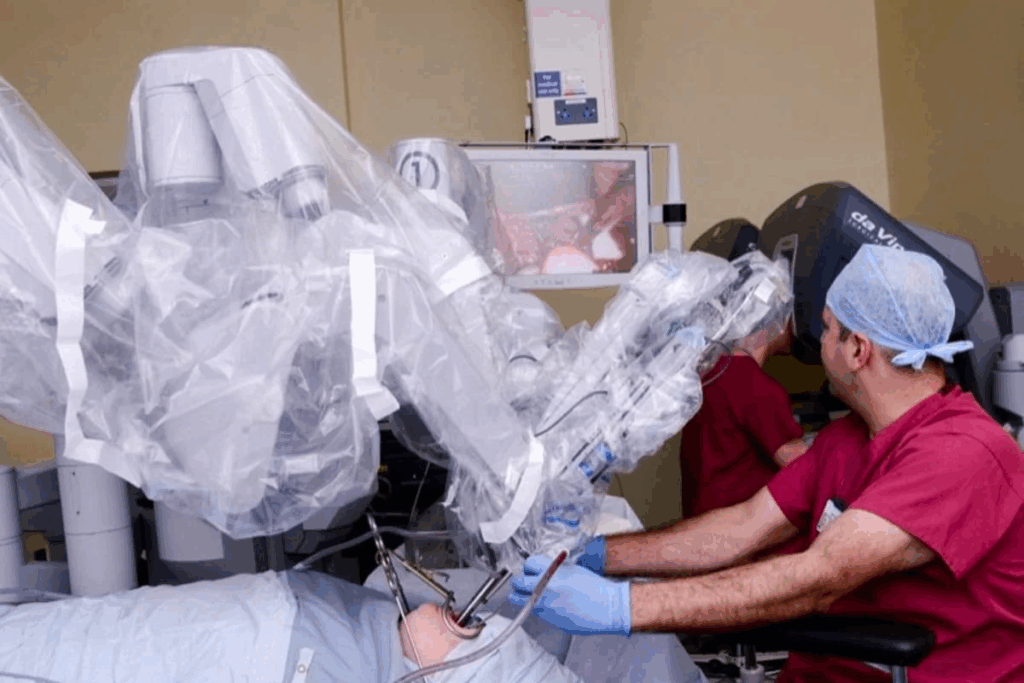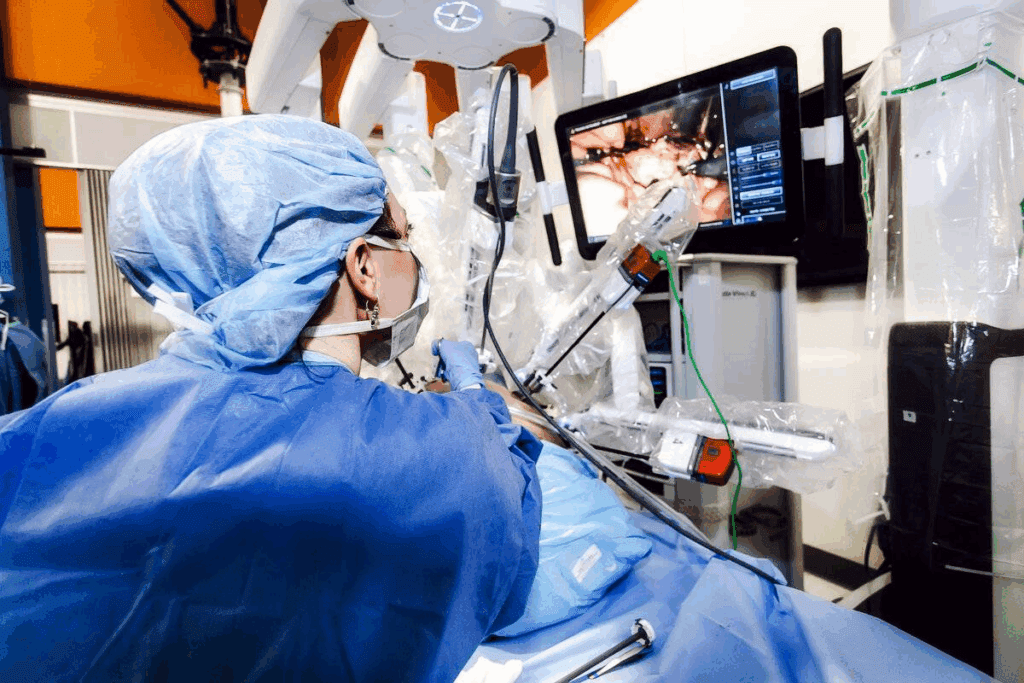Last Updated on November 27, 2025 by Bilal Hasdemir

Robotic hysterectomy is a common surgery for women, with over 150,000 done each year in the U.S. Knowing how to recover is key for a smooth and safe healing. Avoid strenuous exercise and heavy lifting after robotic hysterectomy. Learn activity restrictions and safe recovery guidelines.Avoid strenuous exercise and heavy lifting after robotic hysterectomy. Learn activity restrictions and safe recovery guidelines.
Women want to get back to their daily lives after this surgery. But, some activities can slow down the recovery process. It’s important to know what to skip during this time.
Knowing what to avoid helps ensure a safe and effective healing.

A robotic hysterectomy uses a robotic system for surgery. It lets surgeons work with more precision and control than old methods. This way, there’s less blood loss, pain, and quicker healing.
The recovery time for a robotic hysterectomy varies. But most women can get back to normal in 4 to 6 weeks. The first two weeks are for rest and following doctor’s orders.
| Recovery Stage | Timeline | Activities |
| Immediate Recovery | 1-2 weeks | Rest, limited physical activity |
| Early Recovery | 2-4 weeks | Gradual return to light activities |
| Advanced Recovery | 4-6 weeks |
Understanding the recovery guidelines allows patients to prevent complications and ensures a full recovery.

The first 24-48 hours are very important. You should rest and not do too much. Drinking water and eating well helps your body heal.
Before you go home, you need to meet some requirements. Your vital signs must be stable, you must be able to manage your pain, and you should be able to take care of yourself. Having someone to help you at home is also important.
| Discharge Criteria | Description |
| Stable Vital Signs | Heart rate, blood pressure, and temperature within normal ranges |
| Adequate Pain Management | Effective pain control through medication |
| Basic Self-Care Ability | Ability to perform daily activities with minimal assistance |
Managing your medications is very important. Always follow what your doctor tells you to do. Knowing about possible side effects and how medicines can interact is also important.
It’s important to know the signs of trouble after surgery. If you have severe pain, a lot of bleeding, fever, or trouble peeing, tell your doctor right away.
Hard exercise can hurt your healing after a robotic hysterectomy. It can raise your blood pressure and heart rate. This might cause bleeding or other problems at the surgery site. Let your body heal fully before you start exercising again.
Rest is important to avoid too much strain.
When you can start exercising again depends on your health and the surgery. Usually, you should wait 4-6 weeks. Start with easy activities like walking.
Always listen to what your doctor says. They know what’s best for you.
Know the signs you’re pushing too hard. These include more pain, swelling, or bleeding. Also, watch for fever or chills. If you see these signs, get medical help right away.
A study found that catching overexertion early can stop serious problems.
Starting hard exercise too soon can cause big problems. These include infection, longer healing times, and serious issues like a pulmonary embolism.
“Rest and following your doctor’s orders are key to avoiding these risks,” a doctor says.
Recovery needs patience and sticking to the rules to be safe and smooth.
How long you can’t lift heavy things varies. It depends on how fast you recover and your surgery details. Usually, you should avoid it for 4-6 weeks after surgery.
For tasks that need lifting, ask family or friends for help. You can also use tools or devices that make lifting easier. For example, use a cart for groceries or laundry.
For moms, not lifting kids is hard. It’s best to have someone else handle the kids at first. If that’s not possible, try to lift them less often and for shorter times.
By sticking to these rules and being careful, you can have a safer and better recovery after your robotic hysterectomy.
It’s best to not drive for 24 to 48 hours after surgery or until you stop taking strong pain meds. Your doctor’s advice and how you’re healing will decide this time.
Several things can make driving hard after a robotic hysterectomy, including:
Having a plan for getting around is vital during early recovery. Think about:
Also, check with your insurance about driving after surgery rules. Some might have special rules or needs.
Following these driving rules helps keep your recovery safe and lowers the chance of problems.
Bending, twisting, and stretching can strain the abdominal muscles and the surgery site. This strain might cause pain, bleeding, or damage to the surgery area. It’s vital to avoid these movements to help the body heal right.
Keeping the right body mechanics is essential during recovery. This means being aware of posture, lifting correctly, and avoiding sudden movements. These steps help lower the risk of problems and aid in healing.
For example, when bending, bend at the knees, not the waist. This reduces strain on the belly. Also, lift with your legs and keep the object close to your body when lifting.
There are safe ways to do daily tasks that reduce bending, twisting, and stretching. For instance, sit down when getting dressed to avoid twisting or bending. Using tools like reachers or grabbers can also lessen strain.
It’s important to avoid straining the abdomen during recovery. Stay away from heavy lifting, bending, or sudden movements. Resting regularly helps prevent complications.
Tips for avoiding abdominal strain:
One big rule is to wait for your doctor’s okay before having sex. This lets the area heal, cutting down infection risks. Doctors usually say wait 6-8 weeks, but it depends on your healing and the doctor’s advice.
Always listen to your doctor about when to start having sex again. Doing it too soon can cause pain, infection, or worse problems that might need more treatment.
Patients should also skip tampons during the first few weeks. Tampons can bring bacteria into the vagina, causing infections. Instead, use sanitary pads for any bleeding or discharge.
How long to avoid tampons varies, but usually, it’s 6-8 weeks or until your doctor says it’s okay.
Starting sex or using tampons too soon can cause problems like:
These issues can be uncomfortable and might need more medical help, even surgery.
Talking openly with your partner about your recovery is key. Explaining the reasons for these rules helps them support you better. It also helps manage expectations and anxiety about sex during recovery.
Discuss your recovery plan, including when it’s safe to have sex, with your partner. This open talk strengthens your support system and aids in a smoother recovery.
| Activity | Recommended Waiting Period | Risks of Resuming Too Early |
| Sexual Intercourse | 6-8 weeks | Infection, bleeding, discomfort |
| Tampon Use | 6-8 weeks | Infection, prolonged bleeding |
Stay away from vacuuming, mopping, or any heavy pushing or pulling. These can hurt your abdominal muscles and mess with the surgery site.
Carrying heavy bags of groceries or laundry can be risky during recovery. Try to avoid these tasks to protect your body.
Stay away from any physical labor that makes you bend, lift, or strain. This includes yard work, gardening, or anything else that might harm your healing.
Alternatives include:
Handling household tasks while recovering can be tough, but there are ways to make it easier. Here are some tips:
Prioritize tasks that must be done and delegate or delay others.
d of taking baths. Showering is safer because it lowers the chance of getting an infection. Baths can let bacteria into the surgical area, causing problems.
When you can start swimming again depends on how well you’re healing and what your doctor says. Usually, you’ll wait until your stitches are out and your incision is fully closed. Always listen to your doctor’s advice to stay safe.
Keeping your incision clean while bathing is very important. Use mild soap and water to clean the area around your incision. Dry it gently, don’t rub it.
To avoid infections, don’t get your incision wet until it’s fully healed. Stay away from hot tubs, pools, and lakes. If you see signs of infection like redness or swelling, call your doctor right away.
Following these bathing and swimming rules helps prevent problems and aids in your recovery after a robotic hysterectomy.
Be careful when climbing stairs. Try not to climb stairs unless you really have to. If you live in a house with stairs, make a temporary room on the main floor.
When you do climb stairs, go slow and hold the handrail. Don’t carry things while you’re climbing stairs to avoid falling.
Walking is good for recovery, but start slow. Begin with short walks around your home. Then, slowly increase how far you walk.
Listen to your body. If you feel pain or discomfort, stop and rest. You can start longer walks later, after your doctor says it’s okay.
Getting more mobile is important for healing. Start with short walks and gradually make them longer. Also, do gentle stretches as your doctor suggests.
If walking is hard or you feel off balance, think about using a walker or cane. These can help you feel safer and more confident. Ask your healthcare provider which one is best for you.
Running and jumping are hard on the pelvic area. r a few weeks. Not running or jumping can lower the chance of bleeding or injury at the surgery site.
It’s best to avoid sports during the early recovery time. When you can start again depends on how well you’re healing and the sport. Usually, it’s 6-8 weeks before you can do strenuous sports again. Always listen to what your doctor says.
Even though you can’t do high-impact activities, there are gentle ways to stay active. These include:
These activities help keep your blood flowing, reduce stiffness, and keep you flexible. They don’t put too much stress on your body.
After a robotic hysterectomy, changing your gym routine is key for a safe recovery. It helps your body heal while you slowly get back into shape.
Always wait for your doctor’s okay before going back to the gym. Usually, this is 4-6 weeks after surgery. But, it depends on how well you’re recovering. Going back too soon can cause problems, like infections or slower healing.
Right after surgery, it’s best to skip the gym. The first few weeks are for rest and avoiding hard activities. Going to the gym too early can harm your body or slow healing.
When you start going back to the gym, stay away from high-impact stuff like cycling classes. These are too hard and might mess up your healing. Choose low-impact exercises that don’t stress your belly or the surgery area too much.
Start with gentle exercises and low-impact cardio. Then, slowly add harder activities as you can. It’s important to listen to your body and not do too much too soon.
By making these changes, you can safely get back to your gym routine after a robotic hysterectomy. This way, you can return to your usual activities without worry.
Knowing what exercises to avoid after a robotic hysterectomy is key. These exercises are good for fitness but can hurt healing if done too soon.
Core exercises need to be avoided for a few weeks after surgery. But, this time can change based on how fast you recover and your doctor’s advice.
Workouts that work the abs too hard can slow healing. Crunches, planks, and heavy lifting should be skipped early on. Instead, gentle stretches and moves that don’t stress the abs are better.
There are safer ways to keep your core strong while recovering. Gentle pelvic tilts and deep breathing work the core without too much strain. Always check with your doctor before starting new exercises after surgery.
Starting back with abdominal exercises should be slow and with your doctor’s okay. Begin with easy exercises and slowly make them harder to avoid problems. Pay attention to how your body feels and adjust your workout plan as needed.
A successful robotic hysterectomy recovery depends on following certain rules. Avoiding hard work, heavy lifting, and high-impact exercises is key. This helps lower the chance of problems and aids in healing.
It’s important to start activities slowly and safely. Listen to your body and don’t push yourself too hard. This way, you can avoid complications and recover well.
A robotic hysterectomy is a surgery to remove the uterus using a robotic system. It’s important to recover well to avoid problems and infections.
Recovery time varies, but most women need 4-6 weeks. Your health and surgery type can affect this time.
Physical activity limits help prevent injuries and infections. They also aid in healing.
No, driving is not safe for 1-2 weeks after surgery. Your doctor will tell you when it’s okay.
Wait for your doctor’s okay, usually 6-8 weeks. Early activity can lead to complications.
Soaking baths are not okay until your doctor says so, about 4-6 weeks. Showers are usually safe. Swimming is okay once your incision heals.
No, avoid heavy tasks like vacuuming. Ask for help or break tasks into smaller parts.
Avoid high-impact activities at first. Your doctor will clear you, usually 6-12 weeks later. Start with low-impact exercises.
Yes, avoid these exercises at first. Your doctor will guide you, usually 6-12 weeks later. Start slow and progress.
Your doctor will help with pain management. Follow their advice and report any concerns.
Watch for severe pain, heavy bleeding, fever, or trouble urinating. Contact your doctor if you see these signs.
Subscribe to our e-newsletter to stay informed about the latest innovations in the world of health and exclusive offers!